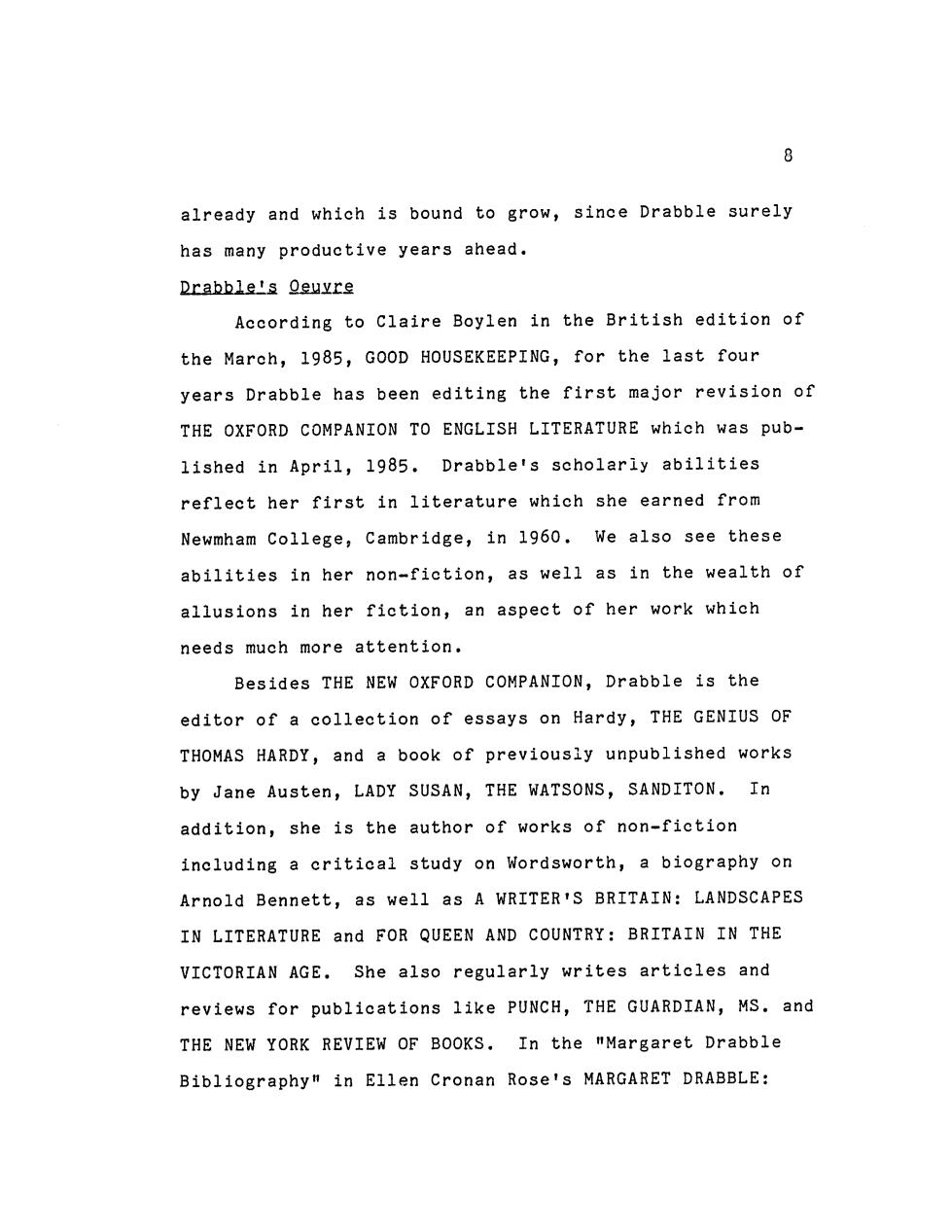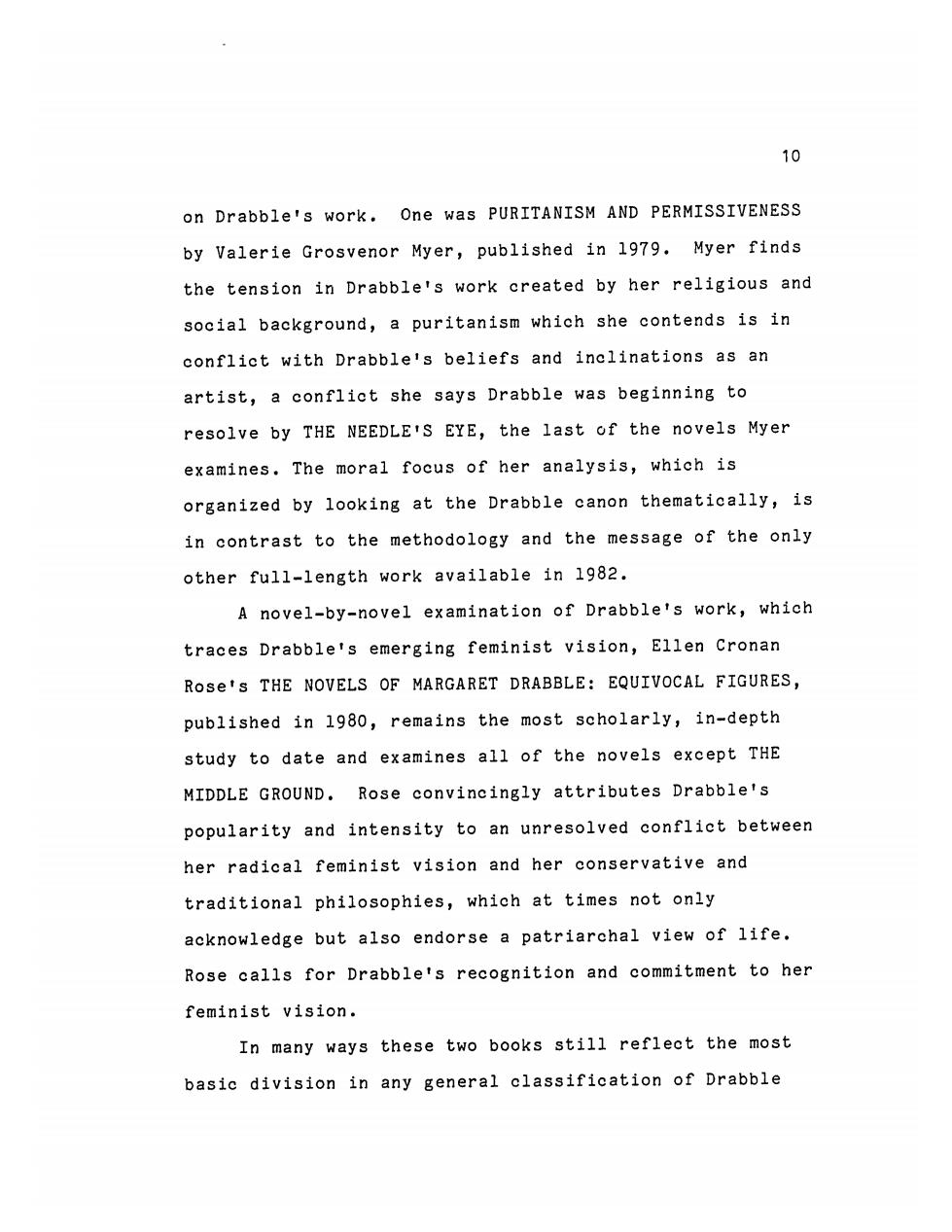
6 final or complete resolution.The open search for meaning in Drabble's novels,rather than the supposition that there is no meaning or that she has the answer to whatever meaning there may be is probably the single most attrac- tive characteristic of Drabble's novels.Connected to this search for understanding is a prevailing sense of hope and optimism,even at times in spite of much evidence to the contrary.Only one novel,THE ICE AGE,for reasons which I discuss in Chapter Six,departs from the prevail- ing mood of hopefulness developed through a consistent recognition of the power of love to create community, connection,and continuity. In the last chapter of FABULATION AND METAFICTION, Robert Scholes calls for an imaginative literature which will heal the cultural psychic split of modern society,a division reflected in a literature which has emersed itself in "alientation."He expresses the need for writers who will create instead a new literature of "integration"(215,216).Scholes believes such a liter- ature is being developed among younger "fabulators"who are "bringing both a concern for the traditional values of story-telling and a fresh vision of human problems and aspirations"(218).Although Scholes does not list Drabble as one of these,he should.Drabble's emphasis on the value of the story,whether it is the story the

7 narrator tells or the stories embedded in the surface story,as well as her sense of hope which prevails in the story are major aspects of her work.Furthermore,she is one writer who is always looking toward the healing of the division,the return to the whole,the integration of the fragments,and she always finds some way to bring her characters together.As she has said her characters don't divide;they are stuck together with a kind of glue. (Hardin interview 282).Even when a character like Jane in THE WATERFALL,who is the most neurotic of Drabble's creations,seems to be schizoid,the first person voice is careful to assure us that Jane knew she would be rescued from her alienation,as indeed she is.In fact, in looking at Drabble's oeuvre,we could say she consistently is a novelist of integration,although never in any reductive way,rather always in an inclusive sense of seeing the possibilities of wholeness as well as recognizing the difficulty of holding the whole for any extended period of time.Looking at the philosophical development and the artistic development of Drabble's work is one of the most interesting aspects of reading and rereading the nine novels.Both philosophically and artistically Drabble continues to be highly ambiguous which certainly is one of the reasons for the increasing critical interest in her work,a canon which is extensive

8 already and which is bound to grow,since Drabble surely has many productive years ahead. Drabble's oeuyre According to claire Boylen in the British edition of the March,1985,GOOD HOUSEKEEPING,for the last four years Drabble has been editing the first major revision of THE OXFORD COMPANION TO ENGLISH LITERATURE which was pub- lished in April,1985.Drabble's scholariy abilities reflect her first in literature which she earned from Newmham College,Cambridge,in 1960.We also see these abilities in her non-fiction,as well as in the wealth of allusions in her fiction,an aspect of her work which needs much more attention. Besides THE NEW OXFORD COMPANION,Drabble is the editor of a collection of essays on Hardy,THE GENIUS OF THOMAS HARDY,and a book of previousiy unpublished works by Jane Austen,LADY SUSAN,THE WATSONS,SANDITON.In addition,she is the author of works of non-fiction including a critical study on Wordsworth,a biography on Arnold Bennett,as well as A WRITER'S BRITAIN:LANDSCAPES IN LITERATURE and FOR QUEEN AND COUNTRY:BRITAIN IN THE VICTORIAN AGE.She also regularly writes articles and reviews for publications like PUNCH,THE GUARDIAN,MS.and THE NEW YORK REVIEW OF BOOKS.In the "Margaret Drabble Bibliography"in Ellen Cronan Rose's MARGARET DRABBLE:

9 CRITICAL ESSAYS,Joan Korenman lists 166 essays and articles by Drabble.Although Drabble is primarily a novelist,she has written four plays,and eleven short stories.The stories have appeared in magazines like MADEMOISELLE,MS,and COSMOPOLITAN and in anthologies like WINTER'S TALES,PENGUIN MODERN STORIES,and THE NORTON ANTHOLOGY OF LITERTURE BY WOMEN.Certainly the size and the diversity of the cannon is reason enough for critical attention,particuarly for a relatively young writer. Her productivity continues with her tenth novel, which she says is "a fairly big novel about the social situation in England now.I plan to have three central characters from varying social spheres and to portray their vastly different lives as interconnected circles" (GOOD HOUSEKEEPING 219).The centrality of women's lives,portrayed in cyclical imagery,is a regular theme in Drabble's work,so we now can only wait to see how Drabble will develop circularity in the new novel and on what types of characters the novel will focus. The Critical Response Certainly many critics are anxiously awaiting the new addition to the Drabble collection.The increasing criti- cal interest in Drabble is demonstrated both in the amount and in the perspectives of the scholarship.When I first read some of the criticism in 1982,there were two books

10 on Drabble's work.One was PURITANISM AND PERMISSIVENESS by Valerie Grosvenor Myer,published in 1979.Myer finds the tension in Drabble's work created by her religious and social background,a puritanism which she contends is in conflict with Drabble's beliefs and inclinations as an artist,a conflict she says Drabble was beginning to resolve by THE NEEDLE'S EYE,the last of the novels Myer examines.The moral focus of her analysis,which is organized by looking at the Drabble canon thematically,is in contrast to the methodology and the message of the only other full-length work available in 1982. A novel-by-novel examination of Drabble's work,which traces Drabble's emerging feminist vision,Ellen Cronan Rose's THE NOVELS OF MARGARET DRABBLE:EQUIVOCAL FIGURES, published in 1980,remains the most scholarly,in-depth study to date and examines all of the novels except THE MIDDLE GROUND.Rose convincingly attributes Drabble's popularity and intensity to an unresolved conflict between her radical feminist vision and her conservative and traditional philosophies,which at times not only acknowledge but also endorse a patriarchal view of life. Rose calls for Drabble's recognition and commitment to her feminist vision. In many ways these two books still reflect the most basic division in any general classification of Drabble